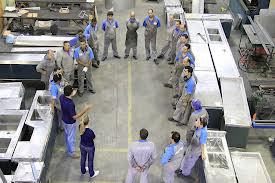Archive
A Few Words from the Crossroads.
Let’s be honest. If you have been in the workforce for any length of time, whether in safety or not, there come times in your career(s) when you reach the crossroads. Those times in your career when you see your future spanning two very different directions. Either reality yields a dramaticly different result that you and your loved ones will reap the consequences of it for years to come.
Such is my position. I have taken on the responsibility of Occupational Health and Safety Manager for the Pepperidge Farm Plant in Bloomfield, Ct.. The position is a dream job I have been training for for my entire college experience. The opportunity is stupendous. The geography is the challenge. Three teenage daughters and a cross country move yields an explosive outcome. My wife has been toting the line of motivating the kids while dealing with the pressures of a move. She is in the trenches packing and supporting her parents family with upcoming weddings and births. She is neck deep in projects.
And then there is me. Standing at the crossroads, looking down one road to Connecticut and the other to Utah. My future lies in Connecticut, but I find that moving is a constant gut-check.
Professionally, I have been keeping myself busy. I have been gleaning safety management ideas from mentors and reviewing case studies in an effort to start supporting this new safety responsibility.
The advice I received surprised me at first. It was uniform, yet specialized. The crux of it bears repeating and I have decided to parrot many of the ideas and objectives here.
According to my sources, the following ideas will ease a manager’s transition:
 1. Wander. By far the most common bit of advice I received was to wander the plant. Wander the factory floor, learn the names of the employees, learn the names of the machines and the processes that the ingredients have to undergo to turn in to delicious treats.
1. Wander. By far the most common bit of advice I received was to wander the plant. Wander the factory floor, learn the names of the employees, learn the names of the machines and the processes that the ingredients have to undergo to turn in to delicious treats.
Wandering allows for you to be seen, and being seen is a part of establishing influence as a manager. Giving others access to you while allowing them to see your human, conversational side creates an influence of trust and dependability.
Wandering as a Safety professional provides yet another benefit…work. I learned firsthand from performing safety audits that the more you look, the more you see. The more wandering you do, the more angles you catch and the deeper into the plant you see.
So, wander. Wander like you’ve never wandered before!
 2. Listen. Safety Managers are hired for their unique knowledge and expertise. They implement programs and plans that will save companies hundreds of thousands (dare I say millions) of dollars. That being said, for a Safety Manager to come running in, both barrells blazing, taking on the responsibility alone and closing all the gaps in the plant at once is stupid. Listen, Listen, Listen!
2. Listen. Safety Managers are hired for their unique knowledge and expertise. They implement programs and plans that will save companies hundreds of thousands (dare I say millions) of dollars. That being said, for a Safety Manager to come running in, both barrells blazing, taking on the responsibility alone and closing all the gaps in the plant at once is stupid. Listen, Listen, Listen!
I have heard the sad tale I just described a few times in my recent interviews. Not surprisingly it doesn’t go well. I know of one situation where the Safety Manager actually kept his job (after a gruelling professional lesson learned). All of the others did not fare as well.
A title gives permission to perform duties. The influence comes after a Safety Manager inserts themself into the work culture.
The “newbie” is best served listening to the experience of the experienced. Machine operators know more about their own machines than the Safety Manager does. Plain and simple.
Listening will open a dialogue and with that dialogue a better risk assessment can be performed.
 3. Follow up. The most imporatant words in business are “follow up.” Even (and especially) when there is no vital information to share. If you are waiting for engineering to come back with an answer then by golly go tell that to the operator. What you are really telling the machine operator is that you value their time, their job experience, and their personal safety by seeing their request through to the end.
3. Follow up. The most imporatant words in business are “follow up.” Even (and especially) when there is no vital information to share. If you are waiting for engineering to come back with an answer then by golly go tell that to the operator. What you are really telling the machine operator is that you value their time, their job experience, and their personal safety by seeing their request through to the end.
The employees you care for must know that you have their backs.
4. Use an action register. Make a list of what you are working on, who the contact people are, and all suggestions you get during the day. Post them and keep up on the list daily. It will help keep you on task and it will report for you when your superiors stop by for unannounced visits.
5. Tote the Corporate Line. Hold the corporate line. Your first few months are essential. People will look for your boundaries and first impressions are lasting. It is essential to show your commitment to the company line.
When I was a teenager, one of my personal Heroes, Karl Farnsworth, gave me a gem of wisdom.
“On One Side of you are your people,” he said.
“On the other side of you is your boss.” He then paused for dramatic effect.
“Which way do you face?”
I thought it over and the lesson was clear to me…Tote the company line. Let your people follow you.
 6. Achieve small victories. Pluck the low hanging fruit during the first few months. I have never walked into a facility for the first time without identifying at least one safety issue that must be addressed. Go get some small victories. The workers will see that you are someone who gets things done. They can see the effect of you being around.
6. Achieve small victories. Pluck the low hanging fruit during the first few months. I have never walked into a facility for the first time without identifying at least one safety issue that must be addressed. Go get some small victories. The workers will see that you are someone who gets things done. They can see the effect of you being around.
7. Avoid the “program of the month” club. Celebrate your victories internally. Avoid the frills and “life-changing rollouts” with new programs. If the safety program is viable it will take on a life of its own. People will follow it and it will become part of the work culture. THEN celebrate the program. If the program bombs when you implement it, then you will have far less egg on your face and it will be easier to dismiss. If the program suceeds then you will find that your influence in the plant will skyrocket.
Like I said at the top of this article, these are the seven pieces of advice everyone I interviewed had in common. Surprising to me during the interviews, but understandable to me now that I review them. They are conservative and have the advantage of being tested over time. They are universal, crossing industry lines and working uniformally. Knowing this yields confidence and makes me excited to get started on the right foot…
…now to get my teenagers on board.
Model Leadership Strategies
In his book, Touch Points, Doug Conant, former CEO of Campbells Soup, stresses the importance of creating your own leadership models. I have been studying up on my own leadership model and have reached a conclusion:
Empower, Uplift, and Share the Wealth
In my own leadership experience, I have discovered that these three actions above all will motivate all involved to a synergistic level. People do not work merely for money, even though they might say they do. If money was the only driving principle there would be a mass exodus from the public sector to entrepreneurship and business schools would be bursting at the seams with aspiring MBAs. No, my experience is rather that people work for the pride of their work. I absolutely know that public employees work for that very reason. I was in management with the Driver License Division in Utah for long enough to know that.
Pepperidge Farm has also taught me the same thing. Recently I was walking down a hall and bumped into a Line Lead. “No one signs the extra work list anymore,” he said with some frustration. “We need people to stay after, and no one is signing up.” Clearly, we work for the pride of our jobs. We work for the recognition of our coworkers and families. We need the money, but believe it or not money is not the driving force behind why we go to work.
I have listed some popular leadership models below. It may be a good idea to see where you think you fit into this list as a leader. As for myself I probably align myself with the Quiet Leadership approach or the Level 5 Leadership model. How is your workplace governed?
Popular Leadership Models
Transactional Leadership: Rules..eh, Rule.  Best used in mature establishments, such as Pepperidge Farm. Rewards are based on achievement, and punishment is dished out for breaking the rules. There is a clear chain of command. The clear advantage is organization, the disadvantage is that organizations that improperly use this organization can focus more on punishments than rewards…rules trump all.
Best used in mature establishments, such as Pepperidge Farm. Rewards are based on achievement, and punishment is dished out for breaking the rules. There is a clear chain of command. The clear advantage is organization, the disadvantage is that organizations that improperly use this organization can focus more on punishments than rewards…rules trump all.
Transformational Leadership: Energy and Vision. For this leadership model there must be one charasmatic leader. People are motivated by a ‘higher cause.’ They are motivated by the idea that they can accomplish anything. Inspiration comes through words and action, not through rules.
Participative Leadership: Democracy…pure and simple. All levels of the company have a say in policy, procedure, etc.. The idea is that with greater participation comes greater comradery.
Situational Leadership: Mold to the Occasion. Leadership models adapt with the situation governing them.
 Charismatic Leadership: Transformational Leadership….on steriods! Leadership hinges on a charismatic leader who motivates with words and reason. Ironically, having one overwhelmingly charismatic leader can smother creativity and imagination in the work force. Things improve only on the scale the leader sets.
Charismatic Leadership: Transformational Leadership….on steriods! Leadership hinges on a charismatic leader who motivates with words and reason. Ironically, having one overwhelmingly charismatic leader can smother creativity and imagination in the work force. Things improve only on the scale the leader sets.
Quiet Leadership: In this model, the leader motivates from behind the scenes. Credit is not taken by the leadership, rather it is attributed to the workforce. Ego and aggression are not worshipped as in some other leadership models because they are not needed. Giving the group credit is meant to raise the standard of excellence without leaving a team member behind. Ironically, Quiet Leadership is usually facilitated by management no less driven than the charismatic leader.
 Servant Leadership: My Responsibility. In this model, the leader is made to feel they have complete responsibility for the outcome of the line. The good of the line outweighs the good of the leader. The leader tends to be self-sacrificial. success belongs to the team, failure belongs to the leader.
Servant Leadership: My Responsibility. In this model, the leader is made to feel they have complete responsibility for the outcome of the line. The good of the line outweighs the good of the leader. The leader tends to be self-sacrificial. success belongs to the team, failure belongs to the leader.
Level 5 Leadership: Quiet/Servant Leadership. This is a mash-up of Quiet and Servant Leadership models. The Company image is more important than the leaders, who merely facilitate the company’s vision. Leaders in this model are not intimidated to hire those who have more experience or education. They are humble, but driven.

